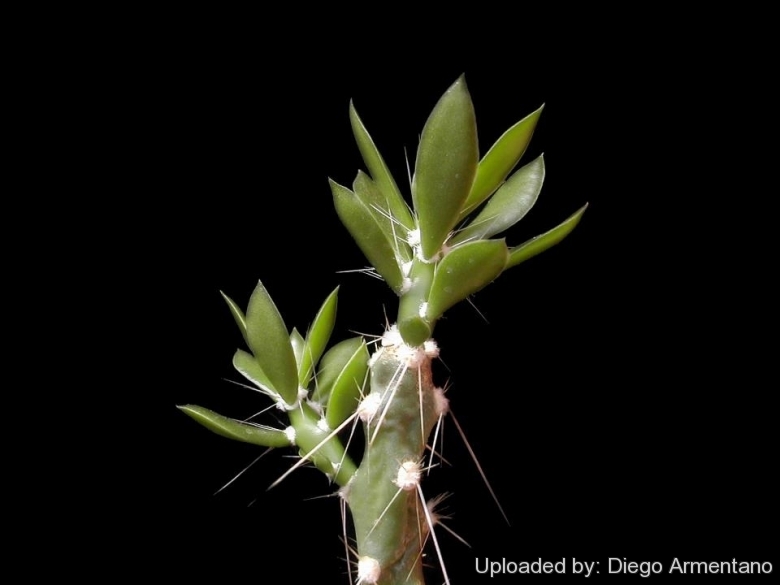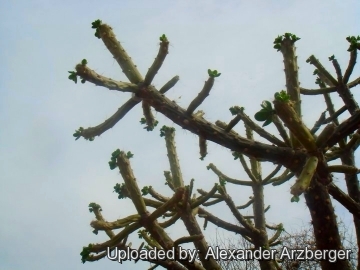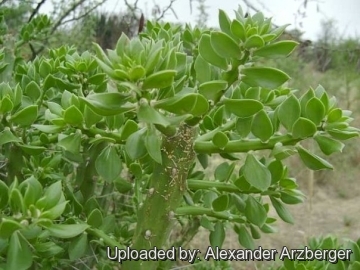Accepted Scientific Name: Quiabentia verticillata (Vaupel) Vaupel ex A.Berger
Kakteen (Berger) 46 46 1929 [Et : Borg in Cacti 53 1937.) (A.Berger)

Pereskia verticillata (Quiabentia verticillata) Photo by: Diego Armentano
Origin and Habitat: Bolivia (Cochabamba, Chuquisaca, Formosa, Santa Cruz and Tarija), northwestern Paraguay, and northwestern Argentina (Chaco, Formosa, Jujuy and Salta). Also reported from Mato Grosso do Sul, Brasil.
Altitude range: 0 to 1000 meters above sea level.
Habitat and ecology: This species is found in dry and low-lying areas, sometimes associated with Pereskia sacharosa. It grows in clay soils. It is consumed by peccaries (Catagonus wagneri). Quiabentia verticillataSN|19004]]SN|19004]] has a wide distribution, is locally abundant, and there are no major threats affecting it. It is favoured by livestock grazing.
Habitat and Ecology: This species occurs in dry and low areas, sometimes associated with Pereskia sacharosa.
Synonyms:
See all synonyms of Quiabentia verticillata
back
Accepted name in llifle Database:Quiabentia verticillata (Vaupel) Vaupel ex A.BergerKakteen (Berger) 46 46 1929 [Et : Borg in Cacti 53 1937.)Synonymy: 8
back
Common Names include:
ENGLISH: Verticillate quiabentia
FRENCH (Français): Quiabentia verticillé
PORTUGUESE (Português): Achuma
SPANISH (Español): Quiabento, Oreja de perro, Sacharosa hembra
Description: Quiabentia verticillataSN|19004]]SN|19004]] is a treelike or shrubby plant 2 to 15 metres high with a distinct trunk.
Derivation of specific name: 'verticillata' from Lat., verticillate; for the branching pattern.
Stems: 1-3 cm thick branching off from the ends (verticillate).
Areoles: Conspicuous with white felt and wool, somewhat persisting.
Leaves: Oval to lance shaped, almost sessile, nearly cylindrical at base, 4-5 cm long, to 2 cm broad, very succulent and almost terete.
Spines: Several, acicular, white, downward pointing, of very variable length, the three longer to 7 cm long.
Flowers: Pale red, 1.5 cm long.
Chromosome number: 2n=22
Subspecies, varieties, forms and cultivars of plants belonging to the Quiabentia verticillata group
 Quiabentia pflanzii (Vaupel) Vaupel ex A.Berger: A tree or shrubs, with fleshy, cylindrical stems and oval leaves rather straggly in habit, 4 to 12 (-15) m tall. Distribution: Paraguay and Bolivia.
Quiabentia pflanzii (Vaupel) Vaupel ex A.Berger: A tree or shrubs, with fleshy, cylindrical stems and oval leaves rather straggly in habit, 4 to 12 (-15) m tall. Distribution: Paraguay and Bolivia. Quiabentia verticillata (Vaupel) Vaupel ex A.Berger: is a treelike or shrubby plant 2 to 15 metres high with a distinct trunk. Stems branching off from the ends (verticillate). Distribution: Bolivia, Paraguay, and Argentina.
Quiabentia verticillata (Vaupel) Vaupel ex A.Berger: is a treelike or shrubby plant 2 to 15 metres high with a distinct trunk. Stems branching off from the ends (verticillate). Distribution: Bolivia, Paraguay, and Argentina.
Bibliography: Major references and further lectures
1) Hunt, D., Taylor, N. and Charles, G. “The New Cactus Lexicon.” dh Books, Milborne Port, UK. 2006
2) Anderson, E. F. “The cactus family” 2001
3) Urs Eggli, Leonard E. Newton “Etymological Dictionary of Succulent Plant Names” Springer Science & Business Media, 29 June 2013
4) Forzza, R. C. “Lista de espécies Flora do Brasil” Jardim Botânico do Rio de Janeiro, Rio de Janeiro.2010
5) Curt Backeberg, Frederic Marcus Knuth “Kaktus-ABC”. Kopenhagen 1936
6) Kiesling, R. and Ferrari, O.E. “100 Cactus Argentinos.” Albatros, Buenos Aires. 2009
7) Neris, N.N. “El Tagua (Catagonus wagneri): dieta y uso del hábitat en el chaco paraguayano.” Universidad Nacional Experimental de los Llanos Occidentales “Ezequiel Zamora”.1993
8) Oakley, L. & Pin, A. 2013. “Quiabentia verticillata.” The IUCN Red List of Threatened Species 2013: e.T152502A644121. http://dx.doi.org/10.2305/IUCN.UK.2013-1.RLTS.T152502A644121.en. Downloaded on 24 March 2016.
9) “Números cromosomáticos para las Cactaceae del Paraguay” retrieved 23 March 2016 from <http://www.ub.edu/botanica/cromopar/citogenetica.pdf>
10) Michael Nee “Flora de la Región del Parque Nacional Amboró Bolivia: Magnoliidae, Hamamelidae y Caryophyllidae” Editorial FAN, 2004
 In habitat. (Quiabentia verticillata) Photo by: Alexander Arzberger
In habitat. (Quiabentia verticillata) Photo by: Alexander Arzberger Pereskia verticillata (Quiabentia verticillata) Photo by: Alexander Arzberger
Pereskia verticillata (Quiabentia verticillata) Photo by: Alexander ArzbergerCultivation and Propagation: Quiabentia verticillataSN|19004]]SN|19004]] is a low maintenance plant that tolerate considerable neglect and will naturalize, it is drought-tolerant; and suitable for xeriscaping, but their spines are so painful it is difficult to recommend them for home gardens. Easy to cultivate outdoor in dry, sandy or gravely, well-drained soils. May be grown in clay soils as long as drainage is good and soils do not remain wet, it is very adaptable both in acid, neutral and basic (alkaline) soils, but prefers a pH in the range 6 to 7.5.
Watering needs: Outdoors little or no water once established, in the green house irrigate regularly from March to October, keep fairly dry in winter, tolerate dry condition but suffer if exposed to prolonged and severe drought. A position at the base of a south-facing wall or somewhere that can be protected from winter rain is best for this plant, but is however resistant to moisture and rain.
Sun Exposure: Full sun (only), in semi shaded position wont produce many flowers.
Frost hardiness: They are not cold hardy, but may survived mild frosts if very dry.
Traditional uses: The leaves can satisfy the thirst in case of lack of water.
Propagation: Propagated by cuttings of segments at any time in the growing season. (Allow cut surface to callus over before planting).











